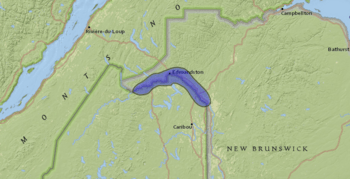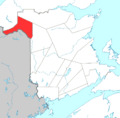Republic of Madawaska facts for kids
Quick facts for kids
Republic of Madawaska
|
|||||||||||||||||
|---|---|---|---|---|---|---|---|---|---|---|---|---|---|---|---|---|---|
| 1827–1827 | |||||||||||||||||
|
Flag
|
|||||||||||||||||

The Republic was made up of local communities on both sides of the St. John river, largely being land close to Edmundston.
|
|||||||||||||||||
| Status | Unrecognized state | ||||||||||||||||
| Capital | n/a | ||||||||||||||||
| Largest city | Edmundston | ||||||||||||||||
| Common languages | English, French | ||||||||||||||||
| Government | Republic | ||||||||||||||||
| "General" | |||||||||||||||||
|
• 1827
|
John Baker | ||||||||||||||||
| History | |||||||||||||||||
|
• Independence declared
|
July 4 1827 | ||||||||||||||||
|
• Arrest of John Baker
|
September 25 1827 | ||||||||||||||||
|
|||||||||||||||||
The Republic of Madawaska (French: République du Madawaska) was a small, self-declared "republic" that existed for a short time in 1827. It was located in a disputed area between what is now New Brunswick (Canada) and Maine (USA). This region included parts of Madawaska County and Aroostook County.
The name "Madawaska" comes from the Miꞌkmaq words madawas (place of) and kak (porcupine). So, Madawaska means "the country of the porcupine." The Madawaska River flows through this area. It joins the Saint John River near Edmundston, New Brunswick, and Madawaska, Maine.
Contents
History of the Madawaska Republic
Border Disputes and Early Settlers
The idea for this "republic" came from a long-standing border disagreement. After the Treaty of Paris (1783), the exact border between the United States and British colonies in North America was not clear. The Madawaska area was one of several places where both sides claimed the land. This dispute lasted until 1842.
In 1817, an American settler named John Baker moved to the region. He lived near where the Baker Brook and Saint John River meet. This spot is now Baker-Brook, New Brunswick. Few people lived in what is now Aroostook County at that time. By 1830, the Madawaska settlement had about 2,487 people.
John Baker's Actions
In 1825, John Baker asked the state of Maine to include Madawaska in its territory. He strongly believed the land belonged to Maine. Baker became very active in challenging British rule. In 1827, he tried to stop mail delivery by canoe from Madawaska to Quebec. He also encouraged French residents to reject British authority. He even prevented a British officer from making an arrest.
Declaring Independence
On July 4, 1827, John Baker held an Independence Day party at his home. He invited all the Madawaska settlers. At that time, 16 American families lived in the Upper Saint John River Valley, along with French settlers.
During the event, Baker declared the entire Madawaska Territory independent. He said it would not follow any authority other than the United States. A flag, sewn by his wife Sophronia Rice, was raised to celebrate the new "republic." After the party, Baker announced another meeting for August 10. They planned to agree on a "Compact" government.
The Madawaska Compact
John Baker, with help from Steven Grover, wrote the Madawaska Compact. This document called for settlers to support each other. It also suggested solving problems through elected judges, without involving British officials.
Baker was to lead this government as "General" of the Republic. Two other men, Charles Stetson and James Bacon, would also help lead. The Compact stated that after one year, the "republic" would ask Maine to become part of the state.
Baker's Arrest and Its Impact
On August 10, a local British official arrived to take the Compact paper. He told Baker to accept New Brunswick's authority. Baker refused, saying he was on American land. Mrs. Baker raised the Madawaska flag again. The official ordered her to take it down, but Baker refused. The official left. Baker then traveled to Portland to ask Maine's governor for protection.
After being away for a month, Baker returned. Three days later, on September 25, he was arrested early in the morning. He was charged with serious acts against the government. He spent 13 months in jail in Fredericton. Baker was found guilty in May 1828. He was fined and jailed for two more months. He refused to pay the fine at first, but eventually posted bond to pay it later.
Baker's situation became an international issue. US President John Quincy Adams asked his Secretary of State, Henry Clay, to look into it. Clay discussed the matter with the British government. Both sides agreed that the US was not responsible for Baker's actions. However, these events made it even more important to settle the border dispute.
Final Border Settlement
In 1831, Baker tried to create a town in Madawaska. This happened after Maine again stated its claim to the disputed northern area. An arrest warrant was issued for him, but he escaped into the woods. Nine years later, in 1840, Baker was fined for encouraging soldiers to leave their army unit.
After a conflict called the Aroostook War (1838–39), the United States and the United Kingdom signed the Webster–Ashburton Treaty on August 9, 1842. This treaty finally settled the border question. The Madawaska region was then given to Canada East (now Quebec). After more discussions, it was given to New Brunswick in 1851.
Today's Influence
The Republic of Madawaska is still remembered by many local people. They often call themselves brayons. A flag for the republic was designed in 1938. It shows a bald eagle and an arc of six red stars on a white background. This flag flies at the city hall in Edmundston, New Brunswick, and at Madawaska festivals.
The mayor of Edmundston, the largest town in the area, also holds the honorary title of "President of the Republic of Madawaska."
Some locals say the idea of the "Republic of Madawaska" comes from a proud answer given by an old settler. When asked by an official, he said, "I am a citizen of the Republic of Madawaska!" This showed his strong local pride.
Canadian author Will Ferguson wrote about "The Republic of Madawaska" in his book Beauty Tips from Moose Jaw: Travels in Search of Canada.
Images for kids
-
Bicentennial version of the Madawaska Flag, with a porcupine.
-
The Republic of Madawaska flag (left), flies along with the Acadian, New Brunswick and Canadian flags in downtown Edmundston, New Brunswick.
See also
 In Spanish: República de Madawaska para niños
In Spanish: República de Madawaska para niños







